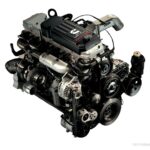The Paccar MX-13 engine is a workhorse in the trucking industry, known for its power and efficiency. However, its Diesel Particulate Filter (DPF) system can be a source of frustration for owners. This article delves into Paccar Mx-13 Delete Reviews, exploring common problems with the DPF, the benefits of deletion, and important considerations before making this modification. We’ll specifically focus on the experiences of those who have opted for a DPF delete on their MX-13 engines.
Understanding the Paccar MX-13 DPF System
The DPF is designed to trap soot and other harmful particulates from diesel exhaust, reducing emissions and meeting environmental regulations. It works by forcing exhaust gases through a filter, capturing the soot. Over time, this filter becomes clogged and requires a process called regeneration to burn off the accumulated soot. This process can be problematic, leading to decreased performance, reduced fuel economy, and increased maintenance costs.
Common Paccar MX-13 DPF Problems
Reviews from Paccar MX-13 owners often highlight several recurring issues with the DPF system:
- Frequent Regeneration: The regeneration process can occur frequently, sometimes every few hundred miles, interrupting operation and consuming extra fuel. This is especially problematic for drivers who operate in stop-and-go traffic or short-haul routes.
- Reduced Fuel Economy: The regeneration process itself consumes fuel, and a clogged DPF can further decrease fuel efficiency due to increased back pressure on the engine.
- Increased Downtime: DPF problems can lead to unexpected downtime for repairs and maintenance, impacting productivity and profitability. Regeneration itself can also require the truck to be parked for extended periods.
- Expensive Repairs: DPF repairs and replacements can be costly, adding to the overall operating expenses of the vehicle. Sensors, filters, and other components can fail, requiring expensive replacements.
Paccar MX-13 Delete: Benefits and Considerations
A DPF delete involves removing the DPF system and reprogramming the engine control module (ECM). Many owners report positive results after a DPF delete:
- Improved Fuel Economy: Eliminating the regeneration process and reducing back pressure on the engine can lead to significant fuel savings.
- Increased Performance: With less restriction in the exhaust system, the engine can breathe more freely, resulting in improved horsepower and torque.
- Reduced Maintenance Costs: By removing the DPF, owners avoid the costs associated with repairs, replacements, and downtime related to the system. This can contribute to significant long-term savings.
However, it’s crucial to consider the legal and environmental implications of a DPF delete.
- Legality: DPF deletes are illegal for on-road use in many jurisdictions. Removing emissions control equipment violates federal and state regulations and can result in hefty fines. This modification is typically only legal for off-road or racing vehicles.
- Environmental Impact: The DPF plays a critical role in reducing harmful diesel emissions. Removing it increases the amount of soot and other pollutants released into the atmosphere.
Conclusion: Weighing the Pros and Cons of Paccar MX-13 Delete
Paccar MX-13 delete reviews suggest that this modification can offer significant benefits in terms of performance, fuel economy, and maintenance. However, the legality and environmental impact must be carefully considered. Before making a decision, thoroughly research local regulations and understand the potential consequences. Consult with a qualified diesel mechanic specializing in Paccar engines to discuss the best course of action for your specific needs and operating conditions.
